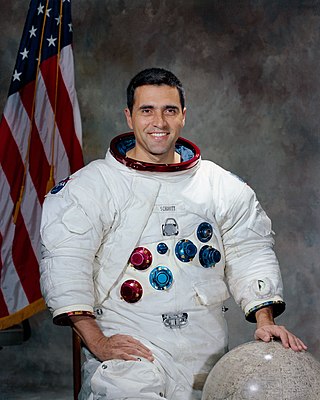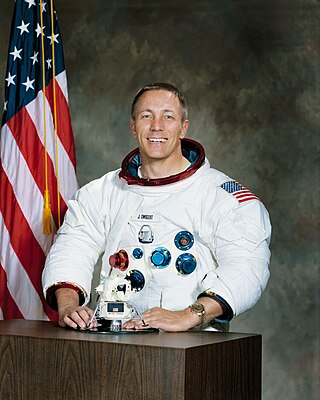
Harrison Hagan Schmitt is an American geologist, retired NASA astronaut, university professor, former U.S. senator from New Mexico, and the most recent living person—and only person without a background in military aviation—to have walked on the Moon.

A satellite or artificial satellite is an object intentionally placed into orbit around a celestial body. Satellites have a variety of uses, including communication relay, weather forecasting, navigation (GPS), broadcasting, scientific research, and Earth observation. Additional military uses are reconnaissance, early warning, signals intelligence and, potentially, weapon delivery. Other satellites include the final rocket stages that place satellites in orbit and formerly useful satellites that later become defunct.

Donald Kent "Deke" Slayton was a United States Air Force pilot, aeronautical engineer, and test pilot who was selected as one of the original NASA Mercury Seven astronauts. He went on to become NASA's first Chief of the Astronaut Office and Director of Flight Crew Operations, responsible for NASA crew assignments.

John Leonard Swigert Jr. was an American NASA astronaut, test pilot, mechanical engineer, aerospace engineer, United States Air Force pilot, and politician. In April 1970, as command module pilot of Apollo 13, he became one of 24 astronauts who flew to the Moon. Ironically, due to the "slingshot" route around the moon they chose to safely return to Earth, the Apollo 13 astronauts flew further away from Earth than any other astronauts before or since, though they had to abort the moon landing.

Charles David "Charlie" Walker is an American engineer and astronaut who flew on three Space Shuttle missions in 1984 and 1985 as a Payload Specialist for the McDonnell Douglas Corporation.

The United States Astronaut Badge is a badge of the United States, awarded to military and civilian personnel who have completed training and performed a successful spaceflight. A variation of the astronaut badge is also issued to civilians who are employed with the National Aeronautics and Space Administration as specialists on spaceflight missions. It is the least-awarded qualification badge of the United States military.

Space Exploration Technologies Corp., commonly referred to as SpaceX, is an American spacecraft manufacturer, launch service provider, defense contractor and satellite communications company headquartered in Hawthorne, California. The company was founded in 2002 by Elon Musk with the goal of reducing space transportation costs and to colonize Mars. The company currently operates the Falcon 9 and Falcon Heavy rockets along with the Dragon spacecraft.
Several planned missions of the Apollo crewed Moon landing program of the 1960s and 1970s were canceled, for reasons which included changes in technical direction, the Apollo 1 fire, hardware delays, and budget limitations. After the landing by Apollo 12, Apollo 20, which would have been the final crewed mission to the Moon, was canceled to allow Skylab to launch as a "dry workshop". The next two missions, Apollos 18 and 19, were later canceled after the Apollo 13 incident and further budget cuts. Two Skylab missions also ended up being canceled. Two complete Saturn V rockets remained unused and were put on display in the United States.
UP Aerospace, Inc. is a private spaceflight corporation headquartered in Denver, Colorado. UP Aerospace provides sub-orbital transportation for corporate, military and educational payloads, via their SpaceLoft XL sounding rocket launch vehicles.

New Shepard is a fully reusable sub-orbital launch vehicle developed for space tourism by Blue Origin. The vehicle is named after Alan Shepard, who was the first American to travel into space and the fifth person to walk on the Moon. The vehicle is capable of vertical takeoff and landings. Additionally, it is also capable of carrying humans and customer payloads into a sub-orbital trajectory.

Spaceport America, formerly the Southwest Regional Spaceport, is an FAA-licensed spaceport located on 18,000 acres (7,300 ha) of State Trust Land in the Jornada del Muerto desert basin 45 miles (72 km) north of Las Cruces, New Mexico, and 20 miles (32 km) southeast of Truth or Consequences. With Virgin Galactic's launch of the VSS Unity, with three people aboard, on May 22, 2021, New Mexico became the third US state to launch humans into space after California and Florida.

The Boeing CST-100Starliner is a class of two partially reusable spacecraft designed to transport crew to the International Space Station (ISS) and other low-Earth-orbit destinations. It is manufactured by Boeing for its participation in NASA's Commercial Crew Program (CCP). The spacecraft consists of a reusable crew capsule and an expendable service module.

Artemis 1, officially Artemis I and formerly Exploration Mission-1 (EM-1), was an uncrewed Moon-orbiting mission. As the first major spaceflight of NASA's Artemis program, Artemis 1 marked the agency's return to lunar exploration after the conclusion of the Apollo program five decades earlier. It was the first integrated flight test of the Orion spacecraft and Space Launch System (SLS) rocket, and its main objective was to test the Orion spacecraft, especially its heat shield, in preparation for subsequent Artemis missions. These missions seek to reestablish a human presence on the Moon and demonstrate technologies and business approaches needed for future scientific studies, including exploration of Mars.

PhoneSat is an ongoing NASA project of building nanosatellites using unmodified consumer-grade off-the-shelf smartphones and Arduino platform and launching them into Low Earth Orbit. This project is part of NASA's Small Spacecraft Technology Program and was started in 2009 at NASA Ames Research Center.

As of 2023, SpaceX operates four launch facilities: Cape Canaveral Space Launch Complex 40 (SLC-40), Vandenberg Space Force Base Space Launch Complex 4E (SLC-4E), Kennedy Space Center Launch Complex 39A (LC-39A), and Brownsville South Texas Launch Site (Starbase). Space Launch Complex 40 was damaged in the AMOS-6 accident in September 2016 and repair work was completed by December 2017. SpaceX believes that they can optimize their launch operations, and reduce launch costs, by dividing their launch missions amongst these four launch facilities: LC-39A for NASA launches, SLC-40 for United States Space Force national security launches, SLC-4E for polar launches, and South Texas Launch Site for commercial launches.

OA-4, previously known as Orbital-4, was the fourth successful flight of the Orbital ATK uncrewed resupply spacecraft Cygnus and its third flight to the International Space Station (ISS) under the Commercial Resupply Services (CRS-1) contract with NASA. With the Antares launch vehicle undergoing a redesign following its failure during the Orb-3 launch, OA-4 was launched by an Atlas V launch vehicle. Following three launch delays due to inclement weather beginning on 3 December 2015, OA-4 was launched at 21:44:57 UTC on 6 December 2015. With a liftoff weight of 7,492 kg (16,517 lb), OA-4 became the heaviest payload ever launched on an Atlas V. The spacecraft rendezvoused with and was berthed to the ISS on 9 December 2015. It was released on 19 February 2016 after 72 days at the International Space Station. Deorbit occurred on 20 February 2016 at approximately 16:00 UTC.

Crew Dragon Demo-1 was the first orbital test of the Dragon 2 spacecraft. The mission launched on 2 March 2019 at 07:49:03 UTC, and arrived at the International Space Station on 3 March 2019, a little over 24 hours after the launch. The mission ended following a successful splashdown on 8 March 2019 at 13:45:08 UTC.

The Boeing Orbital Flight Test-2 was a repeat of Boeing's unsuccessful first Orbital Flight Test (OFT-1) of its Starliner spacecraft. The uncrewed mission was part of NASA's Commercial Crew Program. OFT-2, using Starliner Spacecraft 2, launched 19 May 2022 and lasted 6 days. Starliner successfully docked with the International Space Station (ISS) on 21 May 2022. It stayed at the ISS for 4 days before undocking and landing in the White Sands Missile Range on 25 May 2022.
Swarm Technologies, Inc. is a company building a low Earth orbit satellite constellation for communications with Internet of things (IoT) devices using a store and forward design. Social Capital incubated Swarm, Craft Ventures was an early investor. On 16 July 2021 Swarm entered into an agreement to become a wholly owned subsidiary of SpaceX.















